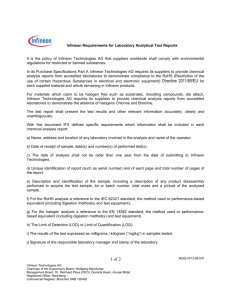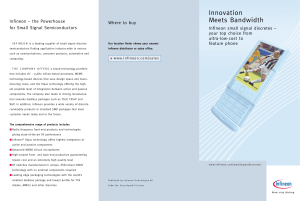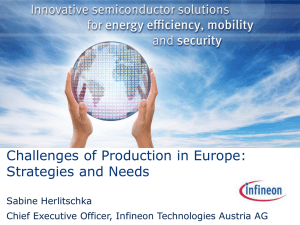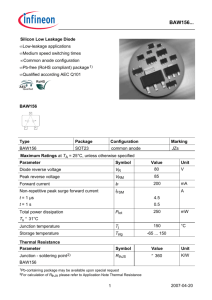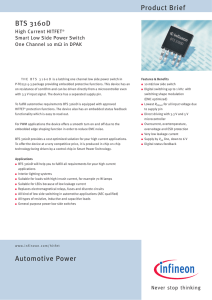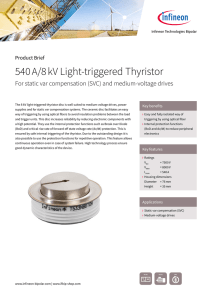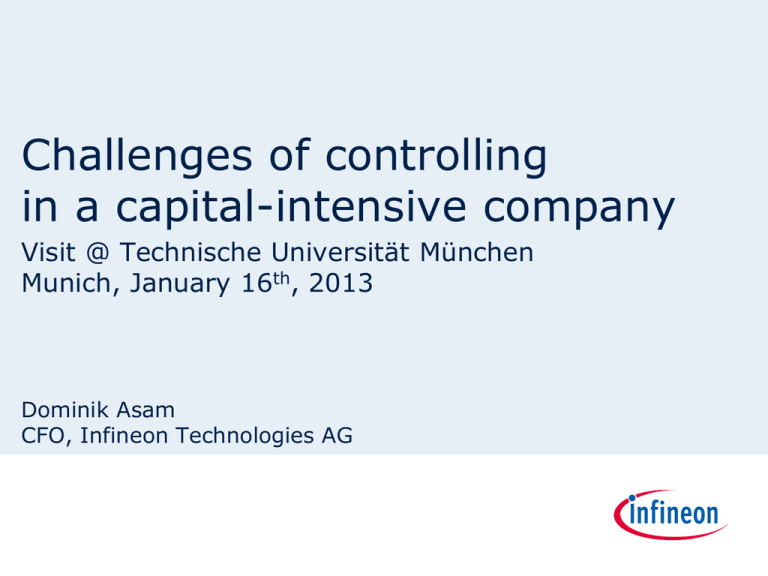
Challenges of controlling
in a capital-intensive company
Visit @ Technische Universität München
Munich, January 16th, 2013
Dominik Asam
CFO, Infineon Technologies AG
Agenda
Infineon at a glance
Key performance indicators
Managing the cycle
Wrap-up
Copyright © Infineon Technologies 2012. All rights reserved.
Page 2
Infineon at a glance
The Company
Infineon provides semiconductor and system solutions,
focusing on three central needs of our modern society:
Energy efficiency, mobility and security
Revenue in fiscal year 2012: €3.904 billion
Headquartered in Neubiberg (Munich), global footprint
26,658 employees (as of September 2012)
Vertically integrated value creation comprising:
21 R&D locations
12 production sites
34 sales offices
Copyright © Infineon Technologies 2012. All rights reserved.
Page 3
Infineon holds top positions in
all targeted semiconductor markets
Automotive
Power
Chip Card
#2
#1
#1
Renesas
14%
Infineon
10%
STMicro
9%
Freescale
NXP
8%
6%
Infineon
Mitsubishi
Toshiba
12%
8%
7%
Infineon
25%
NXP
24%
Samsung
6%
STMicro
Int. Rectifier 5%
SHHIC
STMicro
21%
18%
10%
Calendar year 2011
Calendar year 2011
Calendar year 2011
Source: Strategy Analytics, April 2012.
Source: IMS Research (an IHS company),
July 2012.
Source: IMS Research (an IHS company),
August 2012.
Copyright © Infineon Technologies 2012. All rights reserved.
Page 4
The ToMM market grows much faster than
global GDP, but it is also more cyclical
Growth rates year-over-year (Q1 1997 – Q4e 2013)
CAGR GDP: 3.7%
CAGR ToMM: 5.6%
(1997–2013e)
(1997–2013e,WSTS)
Forecast
70%
Real GDP
4%
50%
3%
30%
2%
1%
0%
10%
1997 ´98
´99 ´00
´01
´02 ´03
´04
´05
´06
´07 ´08
´09
´10
´11
`12 2013e
ToMM
-1%
-2%
-10%
-30%
-3%
-4%
-5%
-50%
Red line: WSTS
Orange line: IHS iSuppli
World semi [ToMM] market growth [y/y%]
World economy, real GDP growth [y/y%]
5%
-70%
ToMM: Total semiconductor market revenue (US-Dollar based) without Memory & Microprocessor.
Real GDP: Inflation adjusted (real) Gross Domestic Product of all countries of the world; total of local values converted with in each case current
US-$ exchange rates. World real GDP is from chain-weighted index. Year-over-year growth rates.
Source: IHS Global Insight (15 November 2012); WSTS (16 November 2012); IHS iSuppli, Interim Q4 2012 AMFT Update (7 November 2012).
Copyright © Infineon Technologies 2012. All rights reserved.
Page 5
We address the market with our
four business divisions
FY 2012 revenue: € 3,904m
Industrial Power
Control
Automotive
ATV
€ 1,660m
IPC
€ 728m
CCS
€ 457m
Chip Card
& Security
PMM
€ 929m
OOS+
C&E*
€ 130m
Power Management
& Multimarket
* Other Operating Segments;
Corporate & Eliminations.
Copyright © Infineon Technologies 2012. All rights reserved.
Page 6
Infineon is the DAX30 company with
the highest revenue share in Asia
Revenue split by region
48% 44%
11% 12%
36% 38%
5% 6%
Americas
therein: 27% 23%
Germany
therein: 17% 17%
China
Asia / Pacific
Europe, Middle East,
Africa (EMEA)
FY 2011
Japan
FY 2012
Copyright © Infineon Technologies 2012. All rights reserved.
Page 7
More than half our global staff are based in
Asia/Pacific
Employees by country
USA
491 employees
181
East Coast
310
West Coast
Europe
12,427 employees
As of FY 2012
Asia/Pacific
13,740 employees
73
Great Britain
1871
Singapore
2988
Austria
2297
Indonesia
8408
Germany
209
India
79
Portugal
7600
Malaysia
34
France
1423
China
94
Italy
20
Hongkong
179
Romania
116
Japan
24
Sweden
87
Korea
541
Hungary
108
Taiwan
7
Other Europe
9
Australia
Copyright © Infineon Technologies 2012. All rights reserved.
Page 8
Finance employees support
our operations worldwide
Countries with employees working in finance functions
1
Germany
Munich
Regensburg
Belecke
Dresden
Ditzingen
2
Austria
3
Hungary
4
Italy
5
Portugal
6
France
7
Great Britain
8
Netherlands
9
Sweden
10
USA
11
Singapore
12
Malaysia
13
Indonesia
14
China1)
15
Hong Kong
16
India
17
South Korea
18
Taiwan
19
Australia
20
Japan
1) China without Hong Kong
9
8
7
1
3
6
2
10
5
20
14
4
17
16
15
12
18
13
11
19
As of FY 2012
Copyright © Infineon Technologies 2012. All rights reserved.
Page 9
Own production capacities are key
to our differentiation strategy
Worldwide production sites
Morgan Hill
Dresden
Kulim
Beijing
Warstein
Wuxi
Singapore
Villach
Regensburg
Frontend (wafer processing in clean room)
Cegléd
Malacca
Batam
Backend (assembly, packaging and testing of individual chips)
Copyright © Infineon Technologies 2012. All rights reserved.
Page 10
Infineon's challenges are reflected
in recent years' figures
m EUR
Revenue
YoY growth in %
FY 2010 FY 2011 FY 2012
3.295
51%
3.997
21%
3.904
-2%
Cost of goods sold
-2.041
-2.332
-2.460
Gross profit
Gross Margin
R&D expenses
In % of revenue
1.254
38%
-399
-12%
1.665
42%
-439
-11%
1.443
37%
-454
-12%
SG&A expenses
In % of revenue
-385
-12%
-449
-11%
-473
-12%
4
8
11
475
14%
786
20%
527
13%
Other oper. inc./exp.
Segment result
In % of revenue
Revenue highly fluctuating due to
cyclical market
High fixed costs due to capital
intensive business model
Gross margin strongly affected by
idle capacity cost (fixed costs!)
High and steady R&D spending
for innovative, competitive
products in the mid to long term
Operating profitability strongly
dependent on revenue growth
Sustainable profitability is challenging goal in the fast moving semiconductor
industry
Good planning of revenue and corresponding manufacturing capacities is very
important, but likewise very difficult due to market cyclicality
Tight controlling is key in order to react fast when economy and markets turn
Copyright © Infineon Technologies 2012. All rights reserved.
Page 11
Agenda
Infineon at a glance
Key performance indicators
Managing the cycle
Wrap-up
Copyright © Infineon Technologies 2012. All rights reserved.
Page 12
Healthy financials as consequence of
a sound business model
Customer value
Financials
High Performance Company Monitor
Financials
Ensure Sustainable
Profitable Growth
Customers
Drive Innovation
for Customer
Success
Differentiate as
Quality Leader
Become Preferred
Partner in Regional
Growth Markets
Processes
Enablers
Constantly Become
Leaner and Faster
People
Have the Right
Competencies in Place
Foster Leadership Excellence
and Build a Strong
High Performance Culture
Copyright © Infineon Technologies 2012. All rights reserved.
Page 13
Drivers
Objectives Goal
Summary value driver tree
for profitable growth
Ensure Sustainable Profitable Growth
15% Segment Result Margin through the cycle
10% revenue growth p.a. through the cycle
Revenue growth with less incremental capital employed
Sustainable Profitability
R&D, SG&A
COGS
Capital Employed Turnover
Capital Employed
(Gross Margin)
Fixed Assets
Sales / R&D
productivity
Project NPV
Travel &
Entertainment
Revenue Growth
Yield
Flow Factor
Capacity
utilization
COGS
productivity
FE/BE fabs &
equipment
(outsourcing)
Licenses
Software
Goodwill
Working Capital
Payment
terms
Inventory
policy
Outsourcing
Copyright © Infineon Technologies 2012. All rights reserved.
Design wins
Pricing
Capacity in line
with demand
Outsourcing
IP license income
Page 14
Our bonus system aims at linking interests of
employees to key performance indicators
KPI
Return On
Capital Employed
(ROCE)
Free Cash Flow
(FCF)
Relevance for Infineon
Shows the linkage between profitability and capital
resources required to run the business
Measures how efficiently Infineon is using its capital resources
ROCE is a very common financial measure in capital markets
and is disclosed by Infineon in the annual report
Measures Infineon‘s ability to generate sufficient cash flows
from its operations to finance the daily business and to
fund the required growth investments
Shows Infineon‘s capability to cover its cash demand without
external sources of financing (like bank loans)
Infineon reports FCF externally on a quarterly basis
Segment Result
Margin
Measures the profitability of a business from regular
operations excluding special effects (internal figure for
operating profit without special effects)
Shows the percentage of revenue which converts into profit
before interest, tax and special effects
Key financial measure reported by Infineon on a quarterly basis
Copyright © Infineon Technologies 2012. All rights reserved.
Page 15
Definition:
Return On Capital Employed (ROCE)
Calculation scheme
ROCE1)
Net Operating Profit After Tax
=
Capital employed
Earnings before interest and taxes (EBIT)
-/+ Non-Segment profit/loss
-/+ Other income/expenses
-/+ Tax expense/benefits
=
Net Operating Profit After Tax (NOPAT)
Total assets
– cash & cash equivalents
– financial investments
– assets held-for-sale
– current liabilities
+ short-term debt
+ liabilities held-for-sale
=
Capital employed
1)
Explanations
ROCE combines the income of a
specific period and the capital used
to generate this income. It measures
how efficiently a company manages
its resources.
ROCE is measured as a percentage.
ROCE from continuing operations (as
opposed to discontinued operations)
forms the base for the incentive
calculation and bonus payouts.
From continuing operations
Copyright © Infineon Technologies 2012. All rights reserved.
Page 16
Definition:
Free Cash Flow (FCF)
Calculation scheme
Net income1)
+
Depreciation & amortization
+/-
Change in working capital
+/-
Other non-cash charges
=
Cash from operating activities1)
+/-
Change in property, plant & equipment
+/-
Change in intangible assets
+/-
Other investing activities
+/-
Change in financial investments
=
Cash from investing activities1)
-/+
Change in financial investments
=
Free Cash Flow1)
1)
Explanations
Free Cash Flow (FCF) is defined as
net cash from operating and
investing activities excluding
purchases or sales of financial
investments.
Free Cash Flow is measured in
Euros.
Again, continuing operations only
(as opposed to discontinued
operations) are taken into account
for the incentive calculation and
bonus payouts.
From continuing operations
Copyright © Infineon Technologies 2012. All rights reserved.
Page 17
Definition:
Segment Result margin
Calculation scheme
Segment Result margin =
Segment Result
Revenue
Revenue
-
Cost of goods sold
-
R&D expenses
-
Sales & marketing expenses
-
General & administration expenses
+
Other operating income
-
Other operating expense
=
Segment Result
Explanations
Segment Result margin measures
the operating performance of a
specific business excluding special
effects.
Segment Result is the operating
income (loss) excluding asset
impairments (net), restructuring
charges and other related closure
costs (net), share-based
compensation expense, acquisitionrelated amortization and gains
(losses), gains (losses) on sales of
assets, businesses, or interests in
subsidiaries, and other income
(expense), including litigation
settlement costs.
Segment Result margin is measured
in percentage.
Copyright © Infineon Technologies 2012. All rights reserved.
Page 18
The bonus KPIs are interlinked and connected
to current financial performance
Interaction of performance and bonus KPIs
FCF
Investing
Cash Flow
ROCE
Operating
Cash Flow
Capital
Employed
NOPAT
Segment
Result
ROCE = Return On Capital Employed
FCF = Free Cash Flow
NOPAT = Net Operating Profit After Tax
Investing Cash Flow = divestments or low
investments affect FCF positively
Positive for bonus KPI
Gross
Margin
Copyright © Infineon Technologies 2012. All rights reserved.
xx
Part of bonus system
Page 19
Deriving target margin from conservative cost of capital
estimate to ensure value creation
Weighted Average Cost of Capital (WACC) = Cost of equity1) = 10-12%
Value creation (EVA > 0) requires: ROCE > WACC
Current revenue
base
Capital expenditure = Depreciation
Rule of thumb:
Future revenue
growth
EUR 1 additional
capital employed
required
for
EUR 1 additional
revenue
ROCE before tax
=
Segment Result
margin
ROCE
=
SR margin x
(1 – 15% tax)
If Segment Result margin > 15% then EVA2) > 0
1)
Cost of debt negligible due to low debt level
2)
Economic Value Added
Copyright © Infineon Technologies 2012. All rights reserved.
Page 20
Agenda
Infineon at a glance
Key performance indicators
Managing the cycle
Wrap-up
Copyright © Infineon Technologies 2012. All rights reserved.
Page 21
Margin targets in four typical semiconductor
market phases
Goal: 15% Segment Results margin over the cycle
Boom
Stable/slightly growing
Margin: around 20%
Margin: around 15%
ToMM growth:
above 6%
ToMM growth:
3 to 6%
Utilization:
over 95%
Utilization:
85 to 95%
Downturn
Recession
Margin: around 10%
ToMM growth: -3 to +3%
Utilization: 75 to 85%
Margin: around 0%
ToMM growth: significantly
below 0%
Utilization: less than 75%
Copyright © Infineon Technologies 2012. All rights reserved.
Page 22
We made high investments in production
capacity during upswing
Investments*
887
325
Depreciation & Amortization
890
~400
453
336
364
428
~ 470
115
FY
FY
FY
FY
FY
2009 2010 2011 2012 2013
Guidance
FY
FY
FY
FY
FY
2009 2010 2011 2012 2013
Guidance
* Investments in property, plant and equipment and in intangible assets; all figures in € million
Copyright © Infineon Technologies 2012. All rights reserved.
Page 23
Investment decisions difficult due to long lead
times before start of production…
1–2m
Equipment
specification
& negotiation
0 – 14 m
1–2m
Equipment lead time
Installation &
Qualification
3–6m
Production
cycle time
Investment decision
Equipment
Equipment
Equipment
Equipment
Equipment
Equipment
Equipment
Equipment
Equipment
Equipment
Equipment
Equipment
Equipment
Equipment
Equipment
Equipment
Equipment
Equipment
Equipment
Equipment
Equipment
Equipment
Equipment
Equipment
Equipment
1
2
3
4
5
6
7
8
9
10
11
12
13
14
15
16
17
18
19
20
21
22
23
24
25
16%
> 12 m
32%
>7m
52%
<7m
Preparation Period (Hook-up – Ready for production)
Lead Time + Preparation Time (Weeks)
Weeks
Time from decision making to sales approx. 18-24 months
Copyright © Infineon Technologies 2012. All rights reserved.
Page 24
… and due to uncertainty regarding market
and revenue (demand) development
20
18
16
14
12
10
8
6
4
2
0
too optimistic
Yr1
LOW
HIGH
too pessimisitic
26%
Yr2
Frequency
20
too opti18
mistic
16
14
12
10
8
6
4
2
0
62%
LOW
HIGH
too pessimisitic
35%
Yr3
Yr4
Yr5
3%
<-6
-5..-6
-4..-5
-3..-4
-2…-3
-1.5…-2
-1.5…-1
-1…-0.5
-0.5…0
0…0.5
0.5…1
1…1.5
1.5…2
2..3
3..4
4..5
5..6
(Year 3 – Year 5)
Long-term
Five-year demand forecast consists of
3 demand scenarios: LOW, MID & HIGH
Past quarterly forecasts (FCs) were
normalized (LOW: -1; HIGH: +1) and
compared with actual figures
Accuracy of mid-term FCs (Year 1 – 2):
Unreliable with extreme deviations
<-6
-5..-6
-4..-5
-3..-4
-2…-3
-1.5…-2
-1.5…-1
-1…-0.5
-0.5…0
0…0.5
0.5…1
1…1.5
1.5…2
2..3
3..4
4..5
5..6
Mid-term
(Year 1 – Year 2)
Frequency
Only 26% of actuals were within the forecasted LOW-HIGH range, no-bell shaped
distribution
Accuracy of long-term FCs (Year 3 – 5):
With 35% within LOW-HIGH range and a
bell shaped distribution more „accurate“
than mid-term FCs
Explanation: long-term FCs converge with
long-term trends, less event-driven
BUT: Too optimistic since 62% of all
actuals were below LOW-value, typical
spreads are 2x higher than LOW and
HIGH estimates (s=21%)
Copyright © Infineon Technologies 2012. All rights reserved.
Page 25
A positive revenue scenario can support an
investment decision …
Scenario 1: Fast market (revenue Q3 FY12)
€m
800
650
600
Assumptions:
Prospect of extra
revenue from Q3 FY12
onwards
Needed capacity
investments: € 430m
400
200
0
-200
Scenario outcome:
-400
Net present value
(i=12%): € 650m
Q1
Q2
Q3
Q4
Q1
Q2
Q3
Q4
Q1
Q2
Q3
Q4
Q1
Q2
Q3
Q4
Q1
Q2
Q3
Q4
FY12
FY12
FY12
FY12
FY13
FY13
FY13
FY13
FY14
FY14
FY14
FY14
FY15
FY15
FY15
FY15
FY16
FY16
FY16
FY16
-600
Cash-out for investments (discounted)
Cash-in from expected extra revenue (discounted)
Cumulated net cash flow (discounted)
Cash back within:
10 quarters
Internal rate of return:
75%
Investment in capacity
attractive
Copyright © Infineon Technologies 2012. All rights reserved.
Page 26
… and a more pessimistic revenue scenario
can oppose an investment decision
Scenario 2: Slow market (revenue Q1 FY14)
Assumptions:
Prospect of extra
revenue from Q1 FY14
onwards
€m
800
600
400
158
200
0
Needed capacity
investments: € 430m
Scenario outcome:
-200
Net present value
(i=12%): € 158m
-400
Q1
Q2
Q3
Q4
Q1
Q2
Q3
Q4
Q1
Q2
Q3
Q4
Q1
Q2
Q3
Q4
Q1
Q2
Q3
Q4
FY12
FY12
FY12
FY12
FY13
FY13
FY13
FY13
FY14
FY14
FY14
FY14
FY15
FY15
FY15
FY15
FY16
FY16
FY16
FY16
-600
Cash-out for investments (discounted)
Cash-in from expected extra revenue (discounted)
Cumulated net cash flow (discounted)
Cash back within:
18 quarters
Internal rate of return:
25%
Investment in capacity
less attractive, idle
capital employed!
Which is the "right" scenario?
Copyright © Infineon Technologies 2012. All rights reserved.
Page 27
Using statistical methods improves
decision making
Monte Carlo Simulation
Is a numerical simulation to estimate
distributions of uncertain outcomes
(such as net present values of
investment decisions)
by running repeated calculations
using probability distributions of
uncertain inputs (such as demand
scenarios, cost assumptions and
operational parameters) and their
correlations
It can also be used for option pricing
Why to use a statistical method?
Copyright © Infineon Technologies 2012. All rights reserved.
Page 28
Testing your gut feeling in a simple example
Isn't the judgment of an experienced manager just as good as a
simulation?
Well, here is a test:
Probability
Imagine the revenue of your business consists of two unrelated
product groups A and B. Each of these contribute approximately € 10.
However, any revenue between € 5 and € 15 is equally likely.
What will your total revenue probability look like?
A
5
15
Revenue
B
5
15
?
10
30
How well do you think you can judge more complex dependencies?
Copyright © Infineon Technologies 2012. All rights reserved.
Page 29
Applying Monte Carlo simulation to an
investment decision
Example: When is additional capacity needed?
Comparing current capacity with the most probable MID demand forecast from
the static three scenario planning (LOW-MID-HIGH), new capacity is needed not
before FY18
But: Is the MID scenario actually to happen? Historical indications:
Long-term MID demand FC on average 10% higher than actual demand,
fluctuating with a standard deviation of 21% due to market volatility
Unknown current market cycle phase poses additional uncertainty
Market cycle phases
Actual demand vs. long-term MID FC
MID level
?
Volatility
s ~21%
Peak
Bottom
100%
90%
Av. actual demand
10% below MID
1 example of 10,000 runs
Copyright © Infineon Technologies 2012. All rights reserved.
Page 30
Monte Carlo simulation creates a more
differentiated picture about capacity needs
Results of Monte Carlo simulation
Result of 10,000 runs
1100000
1,100
Total demand
(short-term fluct.)
600
600000
NEW AREA
needed
FY14
30%
Capacity buffer
Probability
Residual 8"
capacity buffer
Total demand
(w/o noise)
Total demand
(w/ noise)
1,600
1600000
(long-term market trend)
0
FY16
50%
Q1 Q3 Q5 Q7 Q9 Q11Q13Q15Q17Q19Q21Q23Q25Q27Q29Q31Q33Q35Q37Q39
FY14
FY16
FY18
FY20
-400
-400000
New capacity area need
69%
NEW AREA
needed
100000
100
FY12
85%
10%
Probability
Total demand
Probability
LSPW starts per week)
8" equiv.
layer
Demand (in thousand
Example of 1 run
50%
NEW AREA
needed
FY18
Copyright © Infineon Technologies 2012. All rights reserved.
10,000 runs with
randomly drawn
input variables
demand and cycle
development
Like MID scenario,
MCS suggests with
50% probability
additional capacity
need in FY18
trigger point for
investment FY16
BUT: with 30%
probability additional
capacity needed
already in FY16
trigger point FY14
Monitor
development!
Page 31
Agenda
Infineon at a glance
Key performance indicators
Managing the cycle
Wrap-up
Copyright © Infineon Technologies 2012. All rights reserved.
Page 32
Infineon aims at a symbiosis of
economy and ecology
IFX is a key enabler of sustainable society
Environmental benefits
CO2 savings enabled
through our products
(1)
4,700,000 tons CO2
Environmental burden
CO2 burden of our total
operations (2) equivalent to
1,100,000 tons CO2
IFX enables a net ecological benefit of
3.6 million tons of CO2 emission reduction per year!
Infineon received the EN ISO 14001 and
OHSAS 18001 multi-site certification.
Infineon is currently Europe’s
only semiconductor company
member in the Dow Jones
Sustainability Indexes.
1)
2)
As one of the first semiconductor
companies worldwide, Infineon joined the
Global Compact Initiative of the
United Nations in 2004.
Considering only automotive products, ballast control, PC power supply, controllers; real figure is higher.
Including manufacturing, transport, travel, material, chemistry, emissions, water, waste water.
Values are based on internal figures as well as official data.
Copyright © Infineon Technologies 2012. All rights reserved.
Page 33
Wrap-up
Important aspects for a sustainable business development
Sustainable business model is a must – both in terms of
economics and ecology
Identification and addressing of overall trends and needs within
business and society
Sound knowledge of fundamental growth trends underlying the
market cycle to avoid distraction by short-term market
development
Be smart about “pricing” flexibility, e.g. options
Aequam memento rebus in arduis servare mentem,
non secus in bonis ab insolenti temperatam laetitia,
moriture Delli (Horace)
Copyright © Infineon Technologies 2012. All rights reserved.
Page 34
Thank you for your attention!
Q&A
Copyright © Infineon Technologies 2012. All rights reserved.
Page 35
Back-up
Copyright © Infineon Technologies 2012. All rights reserved.
Page 36
Infineon – Market-oriented business structure
Core Applications
Automotive
Powertrain; Hybrid and electric cars (drive control for
electric motor, battery management, charger); Chassis
and comfort electronics; Safety.
Industrial
Power Control
Renewable energy generation, transmission;
uninterruptable power supplies; electric drive control for
industrial applications; industrial vehicles; traction; home
appliances.
Power
Management
& Multimarket
Power supplies for computers; Power supplies for
consumer electronics; Mobile devices for communication
and navigation; Cellular phone network; Infrastructure;
Inverter for photovoltaic rooftop systems; Light
management incl. LED lighting.
Chip Card &
Security
Mobile communication; Payment systems; Near Field
Communication (NFC); Electronic passports, ID cards,
healthcare cards, driver licenses; Transport, ticketing,
access control; Trusted computing; Authentication (e.g.
for pay TV, games consoles, accessories, spare parts,
industrial controllers).
Copyright © Infineon Technologies 2012. All rights reserved.
Customers
Divisions
Page 37
New era: driving demand for
power semiconductors
'90 – '10
'10 – '30
Changes
Electrification of powertrain fuels demand
for high-power semis in cars and doubles
silicon content.
Courtesy: Tesla
Shift towards renewable energies
requires orders of magnitude more highpower semis per MW of power generated.
Higher efficiency in power conversion
lowers CO2, material and electricity costs.
Courtesy: Facebook
Stronger demand for goods containing
power semis due to faster increase in
standard of living in BRIC countries.
Copyright © Infineon Technologies 2012. All rights reserved.
Page 38

